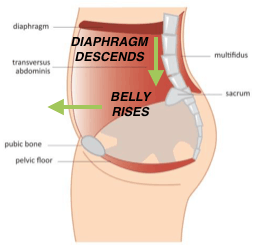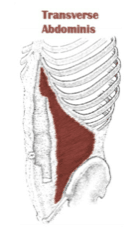Most of us don’t pay much attention to how we are breathing—after all, it’s just something we can do unconsciously as we move through the world. But with a little effort, we can learn to adjust our breathing to suit particular activities. Diaphragmatic breathing stimulates our vagus nerve and helps us relax, and transversus abdominus breathing protects our spine as we move. Keep reading to learn more!
DIAPHRAGMATIC BREATH FOR RELAXATION
Diaphragmatic breathing is a relaxation breath. This breath type facilitates relaxation and is very helpful in promoting sleep and decreasing or preventing anxiety.
During diaphragmatic breathing, the belly is relaxed. With each inhale, the diaphragm descends and the belly rises.
TRANSVERSUS ABDOMINIS BREATH FOR ACTIVITY
Transversus Abdominis (TA) breathing is an active breath. We use this type of breathing when we are moving or preparing to move, because it protects the spine by providing stability at the low back and pelvis.
During TA breathing, the engaged transversus abdominus muscle offers resistance to the descending diaphragm. So, instead of the belly rising, the air expands the lower ribs to each side.
WHAT IS THE TRANSVERSUS ABDOMINIS?
The Transversus Abdominis (TA) is a deep muscle that acts like a corset to stabilize the low back.
To feel it engaged, place your fingers a few inches in from your hips. As you exhale, pull in your belly just below your navel and you will feel your TA tense beneath your fingers.
Take some time to practice these breaths as you go about your day-to-day life. With practice, they’ll feel as natural as, well, breathing!




Comments